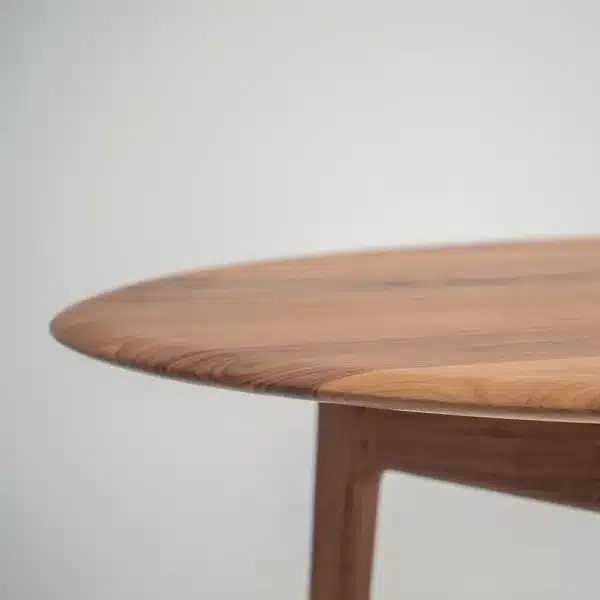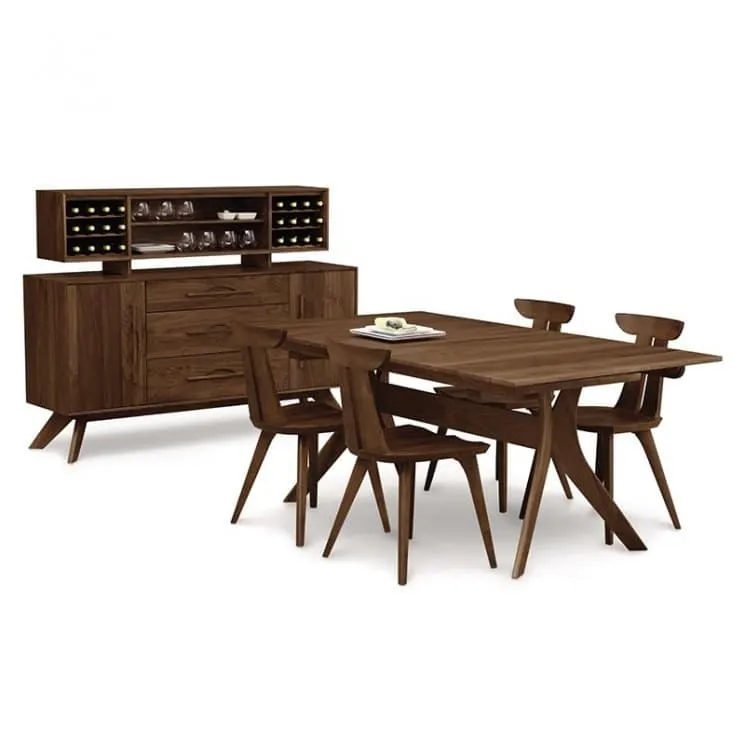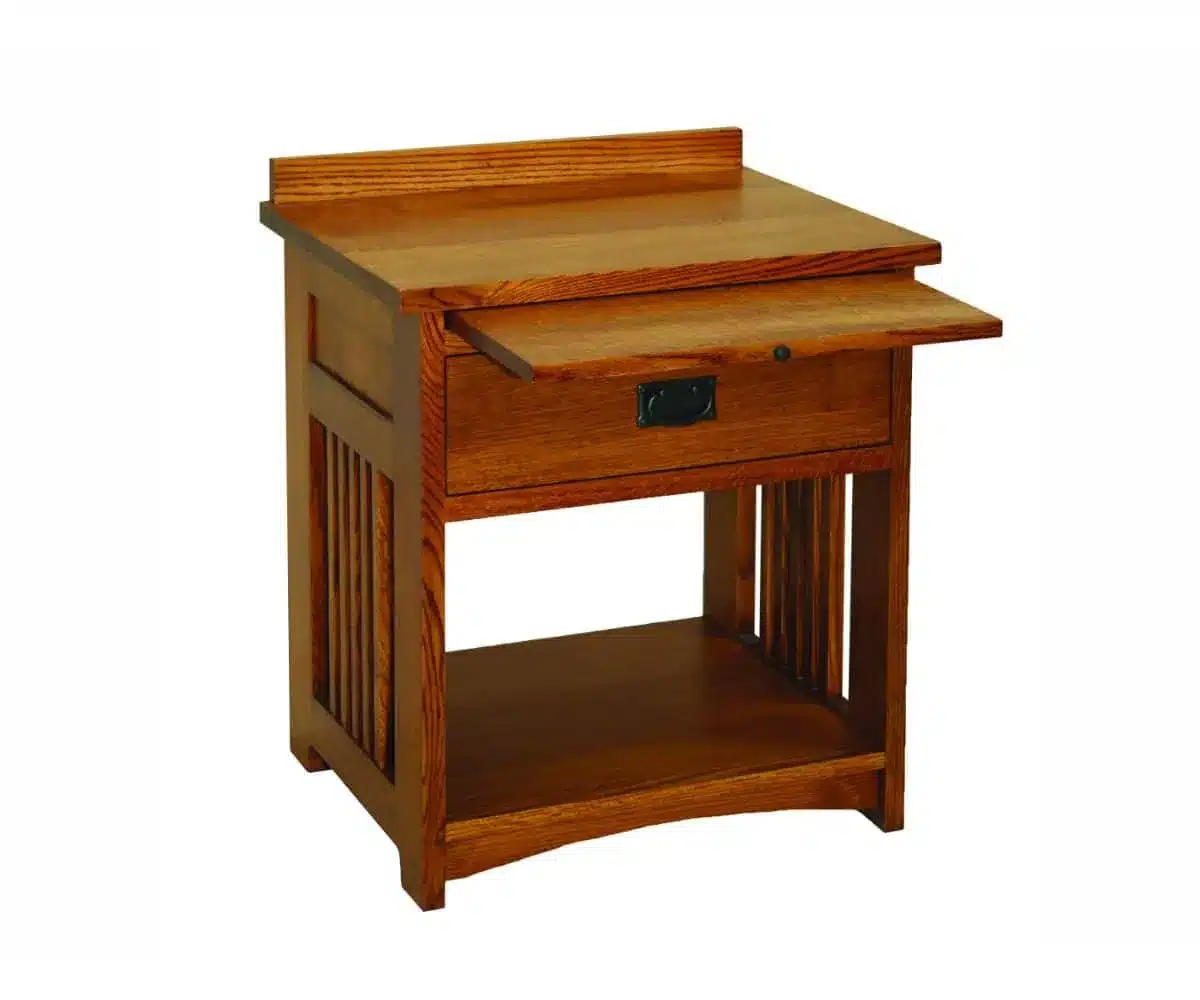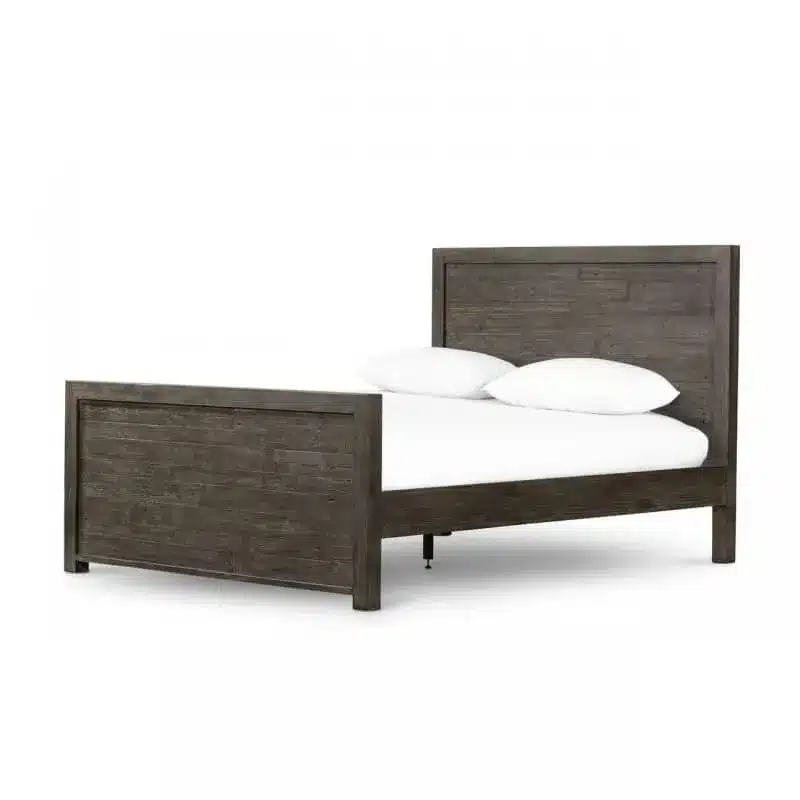Non-Toxic Wooden Furniture Guide
Written by:
Maia James
04/05/2022

Updated: 01/16/2024
Looking for a different guide? Browse them all HERE.

1. Clean Sleep 2. Medley 3. Copeland 4. Vermont Woods Studio 5. Avocado
When you think of natural, non-toxic furniture materials, wood probably comes to mind immediately.
In theory, wooden furniture should be free of toxins, but there are several things to look out for when considering a bed frame, dresser, dining table, etc.
In fact, finding truly non-toxic wooden furniture can be just as challenging as finding a non-toxic sofa!
We created this Non-Toxic Wooden Furniture Guide to help you choose safer wooden items for your home. Read on for our favorite brands, as well as the verdict on big box stores like West Elm and Wayfair.
Three Key Components of Non-Toxic Wooden Furniture
When we look at wooden furniture, we have to consider three major components that can contribute to its toxicity. These are:
- The wood itself.
- Glues and other adhesives.
- Paints, stains, and other finishes on the wood.
Now let’s look a little bit closer at each of these components.
The “Wood” Itself
Wood seems like a straightforward material, but not everything that appears to be wood is truly solid wood. Many non-upholstered furniture items such as dressers, cabinets, chests, desks, bed frames, and tables are actually made from what’s known as “composite wood” or “engineered wood.”
These wood-like materials include plywood, particleboard, chipboard, and medium-density fiberboard (MDF). All are comprised of sawdust or chips of wood that are glued together to make less expensive “wooden” furniture. A thin wooden veneer is glued to the composite wood to give it the appearance of solid wood.

The primary concern with any of these composite woods is in the adhesives used to meld wood pieces together. These toxic glues usually contain a variety of problematic ingredients, the most notable being formaldehyde, which is an established carcinogen.
Chronic exposure to formaldehyde can cause central nervous system damage and respiratory disease, including asthma. As scary as that sounds, the risks posed by a piece of composite wooden furniture are probably pretty small. That’s because the phenol-free formaldehyde that is used today off-gasses quickly.
Beyond toxicity, another concern with furniture made of engineered wood is that it tends to be less durable than solid wood furniture, making it a less sustainable choice.
Our Favorite Wooden Bed Frame
Is there such thing as non-toxic composite wood?
–Choose plywood over similar materials. Plywood typically off-gasses less than do MDF or particle board.
–Look for certifications. Make sure that they any piece of composite wood furniture is compliant with TSCA Title VI or CARB II. GREENGUARD and GREENGUARD Gold are even better. You’ll read more about these certifications below.
-If you’re in the market for plywood for a building project, check out PureBond plywood, which is formaldehyde-free.
Adhesives
We’ve already established that the glues used composite wood are often toxic. The same adhesives are also used to hold together different parts of a piece of furniture.
So even furniture made from solid wood may include adhesives in the joints and elsewhere–and these will be similarly problematic in terms of formaldehyde.
Paints, Stains, & Other Finishes
Choosing only solid wood furniture is a great start, but furniture finishes can be another source of toxins. It is often difficult to determine exactly what materials are used in wood finishes, especially when it comes to products from a big-box furniture store.
Fortunately, most wood finishes emit their fumes during the application and drying or curing processes; once fully cured, most wood finishes are inert and non-toxic.
Clear finishes can contain high levels of volatile organic compounds (VOCs, or the fumes you might smell), although these too will dissipate with time. Many furniture manufacturers add solvents to their finishes to decrease the time it takes for them to cure. Common wooden finisher solvents contain arsenic and beryllium, which are of particular concern if used on a tabletop or other food-adjacent surface.
Fortunately, there are several safer wood finishes, including:
- Tung oil. If you can choose your finish, or are finishing a piece of wooden furniture yourself, tung oil is a great option. Be sure to choose tung oil formulated without driers.
- Linseed oil. Linseed oil can provide a toxin-free finish, but you need to be sure you get either raw linseed oil or polymerized boiled linseed oil. Avoid the common “boiled linseed oil” that doesn’t specify that it is polymerized. Boiled linseed oil is blended with plasticizers, hardeners, and heavy metals. You can read more on linseed oil here.
- Beeswax. Beeswax-based finishes can be non-toxic, but these need to be melted down and mixed with tung or linseed oil to be applied. Once again, you’ll need to make sure you’re getting the right kind of either of those (see above).
- Shellac. A byproduct of a type of bug, shellac can be a great toxin-free finish. Unfortunately, it often contains a toxic solvent, the most concerning of which is methanol.
- Water-based finishes. Some water-based finishes are non-toxic, but be aware that not all of them are. We like AFM Safe Coat DuroStain. Although not “natural,” water-based polyurethane finishes are safe. Be sure to avoid oil-based polyurethane finishes, though, as these are decidedly toxic.
- Paints, stains, and other colored finishes. Colored finishes like paints and stains can emit high levels of VOCs during application and drying. You can learn more about safer paint options here.
If you’re using any oil-based products to finish wooden furniture yourself, be sure to do so in a well-ventilated space to reduce your exposure to VOCs.
Because everyone asks about Wayfair…
As you probably know, Wayfair is a huge importer of furniture that’s made all around the world. Their catalog is so vast (and changes by the minute) that it is impossible to review even a fraction of their wooden furniture. Wayfair certainly offers some solid wood options, but they don’t seem to offer much furniture with certifications of any kind.
Non-Toxic Wooden Furniture Labels & Certifications
There are a few key labels and certifications to look for to identify safer or non-toxic wooden furniture.

As we’ve mentioned, formaldehyde is the most concerning toxin in most wooden furniture. In the United States, the EPA has acted to limit formaldehyde emissions.
All composite wood products made or sold in the United States must have the label “TSCA Title VI compliant.” For products manufactured or imported prior to March 2019, look for that label or one that specifies that the items is CARB ATCM Phase II compliant.
TSCA Title VI sets limits on formaldehyde emissions, but compliance does not mean that products are formaldehyde-free or totally safe. A voluntary and more comprehensive standard is GREENGUARD certification, which limits VOC emissions, including but not limited to formaldehyde.
There are two levels of GREENGUARD certification. GREENGUARD Gold certification is the highest bar. For comparison, furniture with the GREENGUARD Gold certification cannot emit more than 220 micrograms total VOCs per cubic meter, whereas the standard GREENGUARD certification allows up to 500 micrograms.
Also, whenever possible, look for products that have the FSC (Forest Stewardship Council) seal of approval. This ensures that products come from responsibly managed forests that provide environmental, social, and economic benefits. This label does not promise non-toxicity, however.
Ways to Offset the Risks of Toxic Wooden Furniture
Unless you have an unlimited budget, you probably are not in a position to replace every piece of potentially toxic wooden furniture in your home. In addition, aesthetic priorities might mean that you choose some pieces that contain composite wood, or finishes that contain formaldehyde or other toxins.
To clear the air, consider our top four air purifying strategies. These are a great way to boost the safety of your home environment:
- Use air purifying machines. For the best active filtration of a range of VOCs, including formaldehyde, we suggest using an effective air purifier. Not all are created equal.
- Ventilate every day. Opening windows will reduce off-gassing from furniture and floors, as will keeping down the humidity and heat in your home. Open your windows daily when the outdoor air is cleanest (typically in the morning).
- Get house plants. Some of the best plants for filtering formaldehyde include Boston ferns, English Ivy, spider plants, and peace lilies.
- Place charcoal bags around. Moso Bags employ a type of bamboo charcoal that reduces formaldehyde from the air. I have several of these around my house, and a couple in my car.
Good Stuff
The following brands offer non-toxic furniture that we consider to be Good Stuff because it’s made from solid wood with safe adhesives and finishes.
Avocado
In addition to safe mattresses, Avocado makes GREENGUARD-certified wooden bedroom furniture, including bed frames, dressers and nightstands.

Clean Sleep
These bed frames are built to our specifications by a small manufacturer. They are made from solid wood and are available as either unfinished or finished with Tried and True tung oil (which is free from toxic driers).

Copeland Furniture
In addition to safe mattresses, Avocado makes GREENGUARD-certified wooden bedroom furniture, including bed frames, dressers and nightstands.

Green Cradle
This company makes solid wood bedroom furniture, either unfinished or finished with linseed oil. They have dressers, chests, armoires, bookcases, nightstands, and cribs.

Kalon Studios
This company makes solid wood bedroom furniture, either unfinished or finished with linseed oil. They have dressers, chests, armoires, bookcases, nightstands, and cribs.
If you’d like to order through our trade program with Kalon, you’ll receive a 7% discount on everything on their site. To begin the process of placing an order this way, email us here with “Kalon” in the subject line and we will be in touch.

Medley
Medley offers a wide range of wooden furniture that is GREENGUARD Gold certified. You can customize your order with nontoxic materials and finishes (Tung oil or beeswax). Get 5% off with code: GOODSTUFF5. (We have the chairs pictured here in our living room!).
Pacific Rim Woodworking
This company makes beds and dressers out of solid wood and PureBond plywood (which has no added formaldehyde). They have options for natural and zero-VOC finishes.

Romina Furniture
Romina makes GREENGUARD Gold certified bedroom furniture for babies, kids, and teens. They use solid wood only, organic natural glues, and a variety of non-toxic finishes.

Savvy Rest
This company uses solid wood to make bed frames, coffee tables, and benches, which are available unfinished or with zero-VOC finishes. (We also love their safe mattresses and upholstered furniture!)

TY Furniture
This company uses solid woods, non-toxic natural oils and wax finishes, and non-toxic glues. They offer a wide range of wooden furniture.

Uplift
Consider this company if you are looking for a standing desk. They offer solid wood as an option for the top, and metal for the legs. The finish has GREENGUARD Gold certification.

Vermont Woods
They offer solid wood bedroom furniture (some pieces have veneer) and desks with very low VOC lacquer.

Viesso
Uses ECOS 0-VOC finishes (which are very well tolerated by the chemically sensitive) or natural oil and wax finishes on wooden furniture. They use 0-VOC glues.

If you’re enjoying this guide, sign up for our Newsletter to be alerted when we publish or update our Safe Product Guides.
Okay Stuff
These brands have at least some products made from solid wood or safer composite wood. Some offer a subset of GREENGUARD Gold certified products. Many don’t divulge specifics about their adhesives or finishes.
Canal Dover
Canal Dover makes solid wood furniture but doesn’t offer specifics on their glues or finishes.

Crate & Barrel
Crate & Barrel does have some solid wood items, but like many others, they use a lot of “engineered wood.” They don’t specifically divulge what their finishes are. Some items from Crate & Kids are GREENGUARD Gold certified, which is why we are calling them Okay Stuff.

Ethan Allen
Ethan Allen deserves a special shout-out as being slightly superior to the other larger brands mentioned here. Ethan Allen has come a long way regarding environmental impact and indoor toxins over the last several years. They have several factories here in the U.S., but they also import items.

Ikea
Ikea says that “solid wood is one of our favorite materials and is part of our Scandinavian heritage,” but most of their furniture is made from fiberboard and plastic. I do appreciate that almost all of the wood they use is now either FSC certified or recycled.

Lulu & Georgia
While not everything on this site is toxin-free, we identified the following L&G items as Good Stuff:
Solid FSC wood indoor/outdoor coffee table.

Lulu & Georgia
Solid wood side table.

Lulu & Georgia
Solid oak shelving.

Lulu & Georgia
3-drawer dresser.

Pottery Barn
Owed by the same parent company as West Elm, Pottery Barn sell some solid wooden furniture, but plenty of items that are engineered wood. They do have some items with GREENGUARD Gold certification, including:
Platform bed

Pottery Barn
Night stand

Pottery Barn
Storage bed

Pottery Barn
Secretary desk

Stokke
Stokke is a European brand that makes a fair amount of wooden furniture for kids, but it has no meaningful certifications. We are still calling Stokke Okay Stuff because the bulk of their most popular chair, the Tripp-Trapp, meets the E.U. Timber Regulations. All pieces of their high schairs are is free of phthalates, they use water-based paints, and their cushions are made of organic cotton.

West Elm
West Elm uses a lot of “engineered wood with wood veneer” in their furniture. They do have GREENGUARD Gold certification for a few select children’s items, including the following.
Twin bed.

West Elm
Extra-wide dresser.

Zin Home
Zin Home offers bedroom furniture, much of it out of reclaimed wood, and some with natural finishes. They might be Good Stuff, but we’re listing them as Okay Stuff because they were not able to give me specifics about their finishes, as the items are made overseas.

Bad Stuff
Williams Sonoma
At the moment, we found one item from WS that qualifies at Good Stuff, so we cannot call this brand Okay Stuff.
If you happen to love this coffee table, it’s Good Stuff!



Maia, Founder & CEO
Note: This article contains affiliate links or sponsored content, which means that if you make a purchase, we may earn a commission. We only recommend products that meet our strict standards for non-toxicity and that we use (or want to use!) ourselves. Thank you so much for supporting the brands that make Good Stuff!
Enjoying this guide?
Join 60K families who rely on our free guides on everything from milk to mattresses! Sign up to get $5 off your first order, access to our ultimate Clean Products Cheat Sheet, and ongoing exclusive access to coupon codes and promotions. Our weekly newsletter is filled with well researched tips and tricks to live a toxin-free lifestyle.
Related Posts
Start Here: 5 Crucial Steps to Decrease Toxins in Your Home
Are Serta Mattresses Toxic?
What Is the Best Non-Toxic Cutting Board?
2023 Safe Non-Toxic Cookware Guide
-
I really like Dapwood Furniture, made in New Mexico with US sourced solid wood.
-
This is so important for us right now, since we are starting a family, we’ve been trying to be more careful about our furniture choices
-
I’m curious why Nomad furniture is no longer on your best list! Has something changed in the way that they build beds? Thanks!
-
Hi, Can you tell me which mattresses you used on the Oeuf bunk bed for your sons?













Leave a Reply
You must be logged in to post a comment.